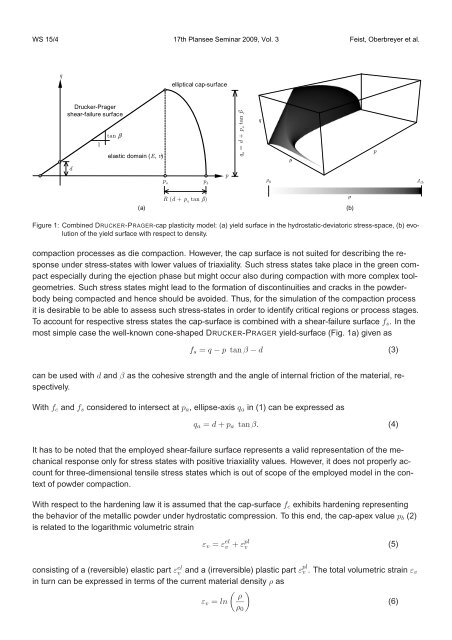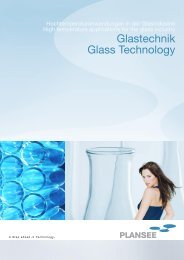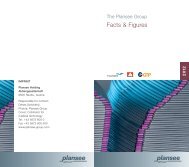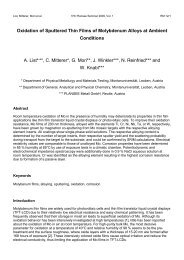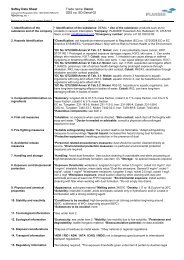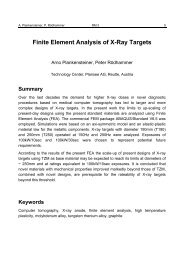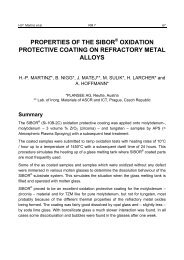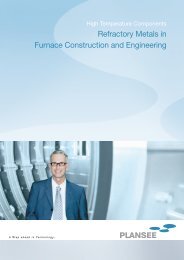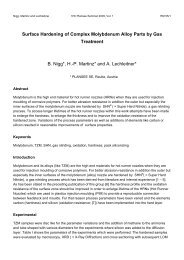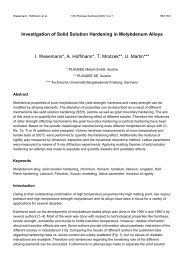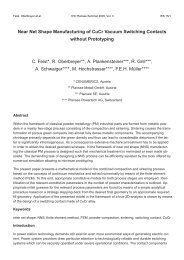Near Net Shape Manufacturing of CuCr Vacuum Switching Contacts ...
Near Net Shape Manufacturing of CuCr Vacuum Switching Contacts ...
Near Net Shape Manufacturing of CuCr Vacuum Switching Contacts ...
Create successful ePaper yourself
Turn your PDF publications into a flip-book with our unique Google optimized e-Paper software.
WS 15/4 17th Plansee Seminar 2009, Vol. 3 Feist, Oberbreyer et al.<br />
q<br />
Drucker-Prager<br />
shear-failure surface<br />
d<br />
1<br />
tan β<br />
elastic domain (E, )<br />
p a<br />
elliptical cap-surface<br />
p b<br />
R (d + p a tan ß)<br />
p<br />
q a = d + p a tanß<br />
(a) (b)<br />
Figure 1: Combined DRUCKER-PRAGER-cap plasticity model: (a) yield surface in the hydrostatic-deviatoric stress-space, (b) evolution<br />
<strong>of</strong> the yield surface with respect to density.<br />
compaction processes as die compaction. However, the cap surface is not suited for describing the response<br />
under stress-states with lower values <strong>of</strong> triaxiality. Such stress states take place in the green compact<br />
especially during the ejection phase but might occur also during compaction with more complex toolgeometries.<br />
Such stress states might lead to the formation <strong>of</strong> discontinuities and cracks in the powderbody<br />
being compacted and hence should be avoided. Thus, for the simulation <strong>of</strong> the compaction process<br />
it is desirable to be able to assess such stress-states in order to identify critical regions or process stages.<br />
To account for respective stress states the cap-surface is combined with a shear-failure surface fs. In the<br />
most simple case the well-known cone-shaped DRUCKER-PRAGER yield-surface (Fig. 1a) given as<br />
q<br />
¡0<br />
p ¡ ¡<br />
fs = q − p tanβ − d (3)<br />
can be used with d and β as the cohesive strength and the angle <strong>of</strong> internal friction <strong>of</strong> the material, respectively.<br />
With fc and fs considered to intersect at pa, ellipse-axis qa in (1) can be expressed as<br />
qa = d + pa tanβ. (4)<br />
It has to be noted that the employed shear-failure surface represents a valid representation <strong>of</strong> the mechanical<br />
response only for stress states with positive triaxiality values. However, it does not properly account<br />
for three-dimensional tensile stress states which is out <strong>of</strong> scope <strong>of</strong> the employed model in the context<br />
<strong>of</strong> powder compaction.<br />
With respect to the hardening law it is assumed that the cap-surface fc exhibits hardening representing<br />
the behavior <strong>of</strong> the metallic powder under hydrostatic compression. To this end, the cap-apex value pb (2)<br />
is related to the logarithmic volumetric strain<br />
εv = ε el<br />
v + ε pl<br />
v<br />
consisting <strong>of</strong> a (reversible) elastic part ε el<br />
v and a (irreversible) plastic part ε pl<br />
v . The total volumetric strain εv<br />
in turn can be expressed in terms <strong>of</strong> the current material density ρ as<br />
� �<br />
ρ<br />
εv = ln<br />
ρ0<br />
(5)<br />
(6)<br />
¡th


